 “The Masonic Lodge, bounded only by the extreme points of the compass, the highest heavens, and the lowest depth of the central abyss, is metaphorically supported by three great pillars, which are denominated WISDOM, STRENGTH, and BEAUTY: because there should be wisdom to contrive, strength to support, and beauty to adorn all great and important undertakings.” (General Ahiman Rezon, by Daniel Sickels, [1868])
“The Masonic Lodge, bounded only by the extreme points of the compass, the highest heavens, and the lowest depth of the central abyss, is metaphorically supported by three great pillars, which are denominated WISDOM, STRENGTH, and BEAUTY: because there should be wisdom to contrive, strength to support, and beauty to adorn all great and important undertakings.” (General Ahiman Rezon, by Daniel Sickels, [1868])That sounds about right at least that is what we are taught. However, what if wisdom, strength, and beauty had another elusion.
In this blog, I thought it would be fun to look at the pillar of “Beauty”, and maybe shed a different light on one of the three lesser lights.
“Beauty to adorn, all great and important undertakings”
I do not know about you, but the statement above seems a little vague, not all undertakings are beautiful. Why use the word “Beauty”?
For those who know me up close and personal, I bet you sense where I may go here, and you are right. Let us look towards the deeper meaning of “beauty”, and a good place to start is the *Kabbalah. In fact, we are heading smack dab into the center, the center of God’s chest.
If you’re not familiar with the Kabbalah, trust me, if you research carefully you will find many believe Freemasonry and Kabbalah share many common denominators. Check out this small description from The Kabbalah Center website:
Kabbalah is not a philosophy or theosophy. Kabbalah is work to be done. The kabbalists of the past were people of action, not people of theory or philosophy. They were constantly traveling from town to town, giving charity, and assisting people in creating better lives for themselves.
I am sure I’ll be addressing the similarities down the road, but for now, let’s take a look at the word beauty from the perspective of the Kabbalah and see if it could be applied to our understanding of the symbolic pillar of Beauty.
In Freemasonry, Mackey states:
Wisdom, Strength, and Beauty were honored by them as supporting pillars for the perfect accomplishment of the works; and thence they considered them symbolically as essential pillars for the support of the Lodge. Wisdom, which, established on science, gives invention to the artist, and the right arrangement and appropriate disposition of the whole and of all its parts ; Strength, which, proceeding from the harmonious balance of all the forces, promotes the secure erection of the building; and Beauty, which, manifested in God's creation of the world, adorns the work and makes it perfect."
“adorns the work and makes it perfect."
If we use wisdom and strength in our endeavors, the result should be beauty, but I contend “Beauty” is actually an active principle. (As is Wisdom & Strength)If we look at the Kabbalah, the sixth sefirah, Tiferet represents beauty and is associated with the center of God's chest.
Tiferet (tiferet -- which literally means "beauty" or "glory”) is the force that integrates the sefirah of Khesed ("Compassion") and Gevurah ("Overpowering"). These two forces are, respectively, expansive (giving) and restrictive (receiving). Either of them without the other could not manifest the flow of Divine energy; they must be balanced in perfect proportion (by sharing), and this is the role of Tiferet, wherein the conflicting forces are harmonized, and creation flowers forth.
As you can see, Beauty as in the Tiferet is the active principle.
“as harmony is the strength and support of all institutions”
Gevurah, on the other hand, sees giving as poisonous (judgment) . Only things earned by equal and fair labor are "good." Thus, it has a powerful ideology of "quid quo pro" and "no free lunches." It sees the ultimate goal of creation as every creature earning its own way.
Tiferet comes along creating a synthesis of both of these approaches. It includes both these approaches because it has a broader goal in mind, and therefore makes use of both. Its goal is "the development of the human being to his greatest potential." (Kabbalah 101 Aish.Com)
I have almost finished reading a real good primer on the Kabbalah, “Nano: Technology of Mind over Matter” by Rav PS. Berg. I recommend it highly!
*Kabbalah — the world’s oldest body of spiritual wisdom — contains the long-hidden keys to the secrets of the universe as well as the keys to the mysteries of the human heart and soul.
#










No comments:
Post a Comment